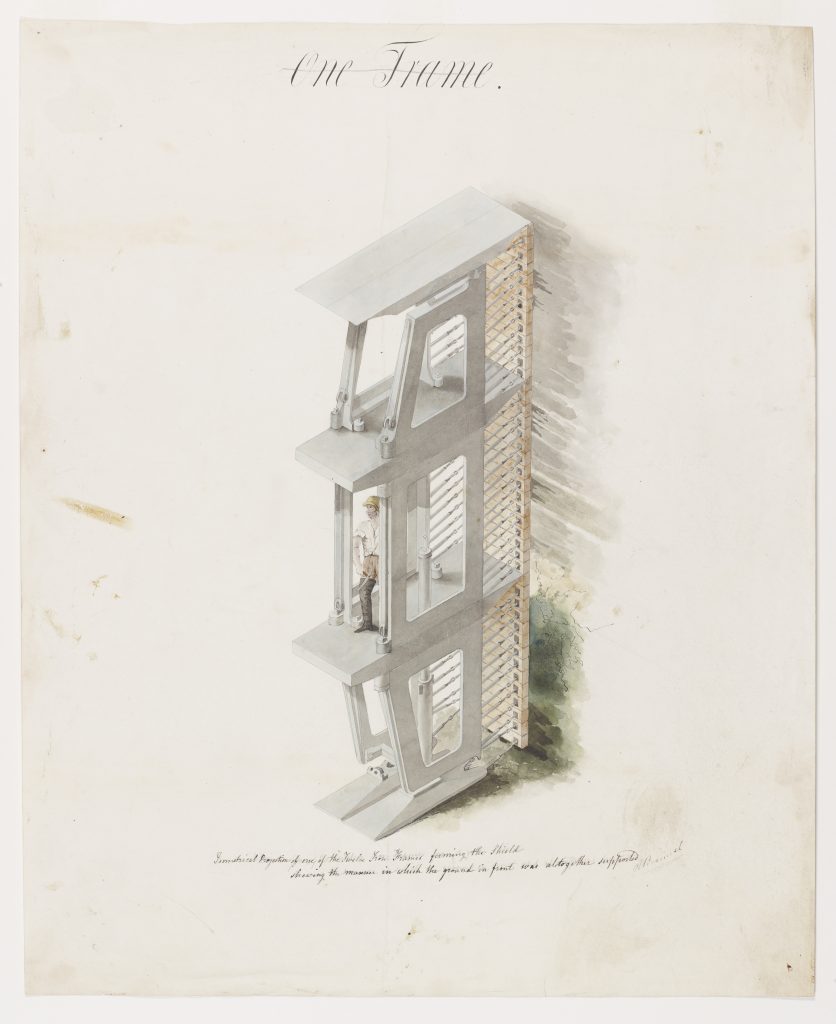This watercolour, signed R. Beamish (Richard Beamish, resident engineer on the Tunnel), provides a clear visualisation of how the tunnelling shield was formed and worked. It is captioned Isometrical projection of one of the Twelve Iron Frames forming the Shield/ shewing the manner in which the ground in front was altogether supported, and depicts a miner in the middle-tier compartment, pickaxe in hand.
A near-identical sketch variant of this drawing was reproduced in Richard Beamish’s ‘Memoir of the Life of Sir Marc Isambard Brunel’ (pp. 219 – 221) in which he describes in detail the illustration:
On the right is the representation of a portion of the ground in front. Against the ground the poling boards supported in place by the poling screws, resting or abutting against the cast-iron frames. On the top the top staves, at the bottom the shoes attached to legs […] The frame will be seen to have been divided into three compartments or cells, each division being 3 feet broad and 21 feet 4 inches high; the 12 frames forming therefore together 36 cells, in which the miners worked independently of one another.
As well as this, a partner piece (LDBRU:2017.3(b)) exists in this collection. It is a copperplate engraving done by William Warrington, who also engraved medallions and other Thames Tunnel-related works. The above watercolour is almost certainly the original from which the engraving was copied and then mass-produced in souvenir booklets sold at the tunnel. Titled An Explanation of the Works of the Tunnel under the Thames from Rotherhithe to Wapping, these booklets described in some detail the way in which the tunnel project was carried out—and included engravings of the shaft, miners, brickwork, and shield.
Together, the pair of illustrations is indicative of the fact that many hands were often involved in a single watercolour – not a single artist or draughtsman. Looking at the diaries of one of Brunel’s employees, Gilbert Blount, Tunnel Superintendent from 1840-42, we know that drawings were often revised, modified, and transferred to other mediums for different uses.
In this case, engravings were a way for Brunel to mass-produce imagery of the tunnel. By this time, technical drawings had become a popular method of communicating the design and functionality of engineering projects. However, in the early 1800s, they had started to be used effectively as a visual medium for engaging a wider, public audience, growing reputation, and even gathering financial support.
Drawings for the workplace often included technical details. Pieces like this one, and its engraved counterpart, however, were far more visually concerned. They often employed pictorialist rendering techniques, including workers or other individuals for a sense of scale, and prioritised reproducibility.
By nature, the Thames Tunnel project was already somewhat of a public spectacle. The series of watercolours and engravings associated with it show the extent to which Brunel and the Tunnel Company aimed to capitalise on this spectacle, and ultimately to ensure the Tunnel’s success, financial and otherwise.
If you’d like a print of the artwork displayed above, you can purchase one from the ArtUK online shop.

